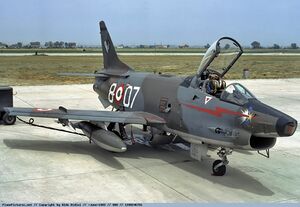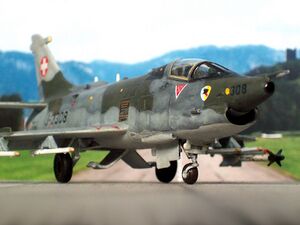Altomare C.53 Passero: Difference between revisions
old>Transnapastain No edit summary |
Ozycaevias (talk | contribs) m (1 revision imported) |
(No difference)
| |
Revision as of 17:12, 4 March 2019
This article is incomplete because it is pending further input from participants, or it is a work-in-progress by one author. Please comment on this article's talk page to share your input, comments and questions. Note: To contribute to this article, you may need to seek help from the author(s) of this page. |
| Athar L-1 Pardal | |
|---|---|

| |
| Role | Fighter-bomber |
| National origin | |
| Manufacturer | Athar Aviation |
| First flight | July 7, 1951 |
| Introduction | October 19, 1953 |
| Retired | 1978 |
| Primary user | Imperial Air Force of Temuair |
| Variants | Athar Ar-15 Escorpión |
The Athar Aviation L-1 Pardal is a single engine light fighter aircraft developed and produced by Athar Aviation in the 1950's. Later variants would enter service to serve as advanced and lead-in fighter trainers, reconnaissance, and attack aircraft. The Athar L-1 would serve as the basis for the Athar A-1 Escorpión twin engine ground attack aircraft which would enter service in the 1960's. The Athar L-1 was the primary combat aircraft of the Imperial Air Force until its replacement by the Athar L-5 Víbora in 1974.
History and development
Design
The Athar L-1 was designed for rough-filed operation,. featuring a tricycle type landing gear configuration and a strengthened undercarriage. Comprehensive service kits were developed to allow for untrained or semi-trained ground crew to service the aircraft at forward operating airstrips under the direction of a single skilled officer. Though generally these measureless are taken by nations utilizing conscript forces, the Aisling military, which is an all-volunteer force, opted to include these features so that other non-essential ground personnel could be used to service aircraft if necessary, thereby ensuring rapid sortie generation.
The aircraft was one of the first Aisling production aircraft to feature a radio navigation and attack system with up to 12 pre-fixed stations can be dialed into the nav/attack system during any moment of flight, with track-to-steer and distance-to-go presentation on the aircraft's heads-up display. The aircraft was equipped with a rear-opening clam shell canopy and a single ejection seat which could be utilized at zero altitude but required the aircraft to be moving at at least 105 miles per hours to be engaged.
Operational history
Variants

- Athar L-1:: Production aircraft entering service in 1953
- Athar L-1A:: Production two seat variant, served as an advanced and lead-in fighter trainer, retained combat capability.
- Athar RL-1:: Two seat battlefield reconnaissance and surveillance built from Athar L-1A with improved avionics and photographic equipment in the nose featuring a single forward-looking camera along with two side looking cameras.
- Athar AL-1 Single seat ground attack aircraft, equipped with jet-assisted take-off equipment to increase take off ability at maximum payload and shortening the take off run to 4,000 ft from a "semi-prepared" runway. Also received an upgraded Areiva AE-231-2 engine, which would become standard on all production aircraft as of 1962.
- Athar L-1B: 1961 upgrade for the Athar L-1 to allow for the use of short-range air-to-air missile and other improvements including avionics and engine upgrades. The Areiva Dardo-I was chosen, and up to four missiles could be carried, however, this addition required one of the aircraft's two Srad CRA.201 cannons to be removed to allow for carriage of the necessary avionics for the missile.
- Athar A-1 Escorpión: A twin engine fighter-bomber built from the Athar AL-1 this aircraft offers higher gross weight and payload than the original L-1
- Athar ZL-1: Retired fighters converted into target tug aircraft.
Specifications
Athar L-1
General characteristics
- Crew: 1
- Length: 10.3 m (33 ft 9 in)
- Wingspan: 8.56 m (28 ft 1 in)
- Height: 4.0 m (13 ft 1 in)
- Wing area: 16.4 m² (177 ft²)
- Empty weight: 3,100 kg (6,830 lb)
- Loaded weight: 5,440 kg (11,990 lb)
- Max. takeoff weight: 5,500 kg (12,100 lb)
- Powerplant: 1 × Areiva AE-231 turbojet, 22.2 kN (5,000 lbf)
Performance
- Maximum speed: 1,075 km/h (580 kn, 668 mph)
- Range: 1,150 km (621 nmi, 715 mi)
- Service ceiling: 13,100 m (43,000 ft)
- Rate of climb: 30 m/s (6,000 ft/min)
- Wing loading: 331 kg/m² (67.8 lb/ft²)
- Thrust/weight: 0.42
Armament
- Guns: 2 x Srad CR.20/38 20 mm cannons
- Hardpoints : 4× under-wing pylon stations holding up to maximum of 1,814 kg/4,000 lb of payload
- Rockets: Areiva CAAD 81 mm rockets
- Bombs: A wide variety of air-to-ground ordinance including gun pods and free-fall bombs.
Athar L-1B
General characteristics
- Crew: 1
- Length: 10.3 m (33 ft 9 in)
- Wingspan: 8.56 m (28 ft 1 in)
- Height: 4.0 m (13 ft 1 in)
- Wing area: 16.4 m² (177 ft²)
- Empty weight: 3,100 kg (6,830 lb)
- Loaded weight: 5,440 kg (11,990 lb)
- Max. takeoff weight: 5,500 kg (12,100 lb)
- Powerplant: 1 × Areiva AE-231-2 turbojet, 22.2 kN (5,000 lbf)
Performance
- Maximum speed: 1,075 km/h (580 kn, 668 mph)
- Range: 1,150 km (621 nmi, 715 mi)
- Service ceiling: 13,100 m (43,000 ft)
- Rate of climb: 30 m/s (6,000 ft/min)
- Wing loading: 331 kg/m² (67.8 lb/ft²)
- Thrust/weight: 0.42
Armament
- Guns: 1 x Srad CR.20/38 20 mm cannon
- Hardpoints : 4× under-wing pylon stations holding up to maximum of 1,814 kg/4,000 lb of payload
- Missiles: Up to 4 x Areiva Picolume air to air missiles
- Bombs: A wide variety of air-to-ground ordinance including gun pods and free-fall bombs.